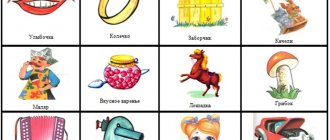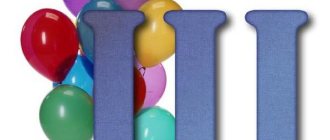According to speech standards, by the age of six, a preschooler’s vocabulary should number more than 2,000 words. The child must use simple and complex sentences in speech, use all three tenses, be able to retell, and correctly pronounce almost all sounds - the only exception is the sound “r”. How to teach a child to pronounce it? Can I do this myself or do I need the help of a speech therapist?
The sound “r” is the most difficult, and children master it last. The root of the tongue and the frenulum must be strong enough to “hold” the sound, and the tip of the tongue must be able to relax so that vibration occurs during a strong exhalation. The sound “r” is long - the tongue must be able not only to rise to the correct position, but also to remain in this position for some time. In addition, the sound “r” requires a very powerful speech exhalation.
By the age of six, the child’s articulatory apparatus should be completely ready to pronounce the sound “r”. However, there are several reasons that may prevent a child from independently coping with pronouncing the most difficult sound.
What prevents you from pronouncing the letter “r” correctly?
The main reasons why this sound is not pronounced are problems associated with the oral cavity.
Short hypoglossal ligament
Another name is bridle. It is this that prevents the tongue from moving freely. Usually this defect is corrected in the maternity hospital. It can also interfere with your baby's ability to latch onto the nipple properly during breastfeeding. If this defect was discovered at school age, it is stretched with speech therapy exercises.
Problems with phonemic awareness
Phonetic hearing is the ability to hear and perceive sounds correctly. At three years old, children should be able to distinguish sounds that are similar to each other, although they cannot yet pronounce them. In some cases, such disorders are associated with adenoids and other diseases. Thus, the child does not hear a certain sound and in his speech he replaces it with another similar one.
Incorrect speech breathing
To correctly pronounce sounds, including the letter P, you need to control your exhalation. Not all children can do this at an early age. Some raise their shoulders to do this, others do not know how to regulate their breathing during speech.
Bite
A correct bite involves the upper teeth overlapping the lower ones by about a third, the remaining teeth should close tightly together. With an incorrect bite, it is physiologically impossible to produce some sounds correctly. The child's bite will need to be corrected.
Causes
Why people burr is the main question that interests burr people.
The first thing you need to understand is the main causes of burr in adults and children:
- Mechanical is a reason that appears as a result of malocclusion, a person’s hard palate or hyperdontia.
- The acoustic reason arises due to the fact that a person confuses similar sounds with each other (for example, “R” and “L”).
- The imitative reason stretches from deep childhood. From birth, a child hears incorrect pronunciation of sounds, but does not understand it. Accordingly, he begins to pronounce sounds in the same way as his parents. For example, the letter r is like the letter l.
- Neuralgic dyslalia occurs due to the appearance of pathologies in certain areas of the brain. They are responsible for correct speech.
- Functional dyslalia appears due to disorders of the speech apparatus: weak muscles and a short frenulum of the tongue.
There is also an opinion that burring is inherited. There is a high probability that if one of the parents burrs, then his child will also inherit this problem.
How can a child distort "R"
Incorrect “r” sounds are called rhotacism - these are the sounds that are replaced instead of this letter. Before determining exercises for producing the sound R, it is necessary to understand exactly how the child pronounces this sound. It happens like this:
- Burr or speaking through the throat. When pronounced, the palate vibrates instead of the tip of the tongue. A similar phenomenon is more typical for French, but not for Russian.
- Lateral "R". This happens if the side is pressed against the upper jaw, the opposite side hangs down. In this case, the tip cannot vibrate, and the sound P itself is more similar to “rl”.
- Single-stroke "r". Instead of shaking, the tip hits the roof of your mouth. This is how the English letter “R” is pronounced.
- Pronunciation through the nose. The air flow must pass through the mouth.
- Kucherskoe R. The tongue vibrates on the pressed lips, resulting in the sound “tpr”, not a pure R.
- Pararotacism. This is the phenomenon of replacing the sound P with another, for example G.L,V.
- Pass. The child simply does not pronounce this sound at all and misses it in his speech.
Breathing exercises
Breathing speech therapy gymnastics:
- "Bubbles." Take a deep breath through your nose, puff out your cheeks and exhale through your mouth.
- "Mill". Feet together, arms up. Rotate with straight arms, saying “zh-r-r” as you exhale. Speed up movements, increase sound.
- "Geese." Walk around the room, flapping your arms like wings. Raise your arms as you inhale, lower them as you exhale, saying “g-oo-oo.”
- "Balloon". Lying on your back, place your hand on your stomach. Take a deep breath and exhale, observing the movement of your hand. Inflate your belly like a balloon.
- "Hedgehog". Imitation of a hedgehog puffing with tension in the muscles of the nasopharynx.
What exercises can you do at home?
Exercises should be aimed at the reason why the child cannot pronounce this sound R.
Exercises for the hyoid ligament
This exercise improves the elasticity of the tongue muscle and develops its mobility. The exercise consists of the following:
- try to reach your nose with the tip;
- the tongue is pressed firmly to the palate and drawn towards the throat as far as possible;
- open your mouth, bend your tongue out as far as possible;
- carried out along the inside of the teeth in different directions;
- rolls up with a shovel and sticks out.
Exercises to develop mobility of the tip of the tongue
The sound P appears only when the tip vibrates. To develop this, there are special exercises:
- bite the tip;
- click the tongue pressed to the palate;
- the protruding tongue is pressed against the lip and air is exhaled, thereby creating vibration at its tip;
- pronounce the letters D, T with your mouth open.
- "D" and "T".
Statement P
Exercises aimed at correct pronunciation:
- R is pronounced in the position of the tongue in which the sounds D and T are pronounced, but with slight vibration. To do this, the tongue is pressed tightly against the palate and the air is exhaled.
- Say "DRRRRR" or "TRRRRR".
- Connecting to the sound of vowels, for example DRO, BRO, VRE.
- Pronounce words with a combination of the letters “tr” and “dr”.
- Consolidating the result with tongue twisters.
It is advisable to do all these exercises in front of a mirror and under the supervision of an adult, who should help and advise.
Articulation exercises
Before starting all the exercises, you need to do gymnastics, and only then proceed to the training itself.
Swing
Loose tongue with open mouth. You need to touch the upper and lower teeth. Periodically lingers on the top for 10-20 seconds.
Cuckoo
The tip sticks out and touches the upper lip, and then goes behind the upper teeth. The mouth should be wide open.
Painter
The tongue is passed over the teeth, cheeks, and palate. The tongue is like a brush and you need to paint the inside of the oral cavity with it.
horse
The tongue makes clicking sounds.
Treat
The tongue licks the lips clockwise.
Kitty
Lick an imaginary treat from a saucer. The tongue should not be curled.
Harmonic
You need to raise your tongue and secure it to the roof of your mouth. In this position, close your mouth.
Hammer
Smile widely and tap your lower teeth with the tip of your tongue.
How to make the sound R
It is recommended to start with setting other sounds, and only after that move on to the letter R.
Drum
Hit your upper teeth with your tongue and at the same time pronounce the letter D. The pace gradually accelerates.
Buzzer
When pronouncing Zh, we slowly pull the tongue towards the throat. The sound Zh should go into R.
Snake
We repeat the letter C and swallow our tongue, touching the tip of the palate with it.
Turkey
You need to stick out your tongue and move it back and forth, making sliding movements with its tip along the roof of your mouth.
Komarik
You need to open your mouth, raise your tongue up and rest it on the alveoli, making buzzing sounds.
Motor
A finger is placed under the tongue and active movements are made. At the same time, the KOMARIK exercise is performed.
How to consolidate the result
If the child begins to pronounce this sound, it is necessary to reinforce this. To do this, there are some exercises:
- say R loudly several times;
- consolidate through the pronunciation of words and syllables with the letter P;
- remove exercises with “D”;
- switch to reverse pronunciations, instead of RA-RO, say AR-OR;
- use tongue twisters.
These exercises will consolidate the result and bring the pronunciation of the letter P to automaticity. At the initial stages, the amount of P should be large. The child must remember and get used to the articulation of this sound. P should be firmly fixed in his speech. An adult should pronounce it together with the baby, showing the correct pronunciation. Then the child must actively use words with R in his speech.
General recommendations for independent speech therapy sessions
- Classes should not overload the child. The length of one “lesson” should not be more than 45 minutes.
- Be sure to alternate types of tasks so that your child does not get tired.
- Support and praise your child for every positive change. You should not swear or get angry if something is done incorrectly. Perhaps while the articulatory apparatus
- is not ready to pronounce such a complex sound, or your son or daughter does not fully understand what he needs to do.
- Use a mirror when practicing. Looking into it, it is more convenient to control articulation.
- Use all kinds of games and entertainment to keep your child interested and prevent him from becoming overtired.
- Lessons do not have to be done at home at the table. Communicate more - on a walk, during everyday activities. Ask questions, encouraging them to pronounce the correct letters.
- Don’t quit classes “halfway”! If it seems to you that the sound has already been achieved, you definitely need to introduce it into speech, bring the pronunciation to automatism. Otherwise, all your and your children’s efforts will be in vain.
- Be friends with your child. Support and encourage each other. By dealing with such a problem, you can convey to him that he can overcome many problems in his life. With your support or on your own.
Date of publication: 07/09/2016. Last modified: 05/09/2018.
Sound production methods
Imitation
In children under six years of age, the sound P often appears as a result of their imitation. That is why adults must speak correctly, clearly, as clearly as possible. Adults must demonstrate perfect phonetic pronunciation.
Exercises from "F"
If the pronunciation of this letter is not impaired, then when pronouncing it, the tongue is moved with a finger or a stick inside the mouth. So the letter Zh smoothly turns into R. This is reinforced by frequent repetition, gradually the child pronounces the desired sound without using an auxiliary one.
If a preschooler pronounces “F” correctly, then when pronouncing it, you can move the tongue with a stick deeper into the mouth. A short “R” is formed. Strengthen it by repeating the exercises. After automating “R”, select words without using “F”.
Exercises from "C"
The child must draw out the letter, inhale and press his tongue against the alveoli. This is how R will appear. By carrying out strengthening exercises, you can achieve complete automation of R in speech.
Production from "Z"
When pronouncing “Z,” the child lightly touches the alveoli with the tip of his tongue and simultaneously blows on the tongue. This way the required “P” will be heard with vibration. This method is similar to the “C” method and is rarely used by speech therapists.
Pronunciation of R while inhaling
Speech is pronounced when inhaling, it should be short.
Mechanical method
The sound R can be produced mechanically. This will require special speech therapy tools. The child should open his mouth and raise his tongue to the palate. At this time, the speech therapist makes tapping movements with a hammer on the alveoli and vibrates the tongue with a spatula. The sound must first be fixed with the help of instruments, then the child gets used to it and can do without them.
The vibration occurs when a wad of thick paper and string is placed on the tip of the tongue. When it is removed from the surface, you need to blow strongly on the tongue. This must be used carefully without injuring the child.
Setting “R” according to Khvattsev
This technique was created by teacher Mikhail Efimovich Khvattsev in 1959. This method consists of several successive steps:
- Composing individual phrases containing similar words that differ by one letter - pitifully hot, thief-ox and others.
- Causing vibrations in the tongue mechanically. To do this, knock on the gums.
- Getting the sound "R" from "D".
- Bringing pronunciation to automaticity, we pronounce syllables and words with this letter.
This technique is actively used today, although it appeared during the USSR period.
Levina's method
Rosa Evgenievna Levina created her own method in 1965, which consisted of articulation exercises for setting the letter R. At the beginning of the lessons, the fricative R is achieved, which does not have a characteristic vibration.
- The second stage is training the sounds Zh, Sh. You need to move your lips apart, but without rounding them. In this case, you need to pull out the sound Zh and move the tip of your tongue to the top.
- At the first stage, the exercises are aimed at obtaining the fricative "P" without vibration after achieving correct articulation.
- To obtain P, D is used, which must be pronounced while exhaling. The mouth should be open and the tongue connected to the upper gums.
Patiently and consistently
Many factors influence a child’s speech culture. Including the general situation in the family. More often, those children who grow up in an atmosphere of love and attention speak well.
Exercises prepared by BrainApps specialists can be performed for preventive purposes. If a problem exists, then consultation with a specialist is mandatory. By bringing a child with problems pronouncing the letter r to a speech therapist, you can receive individual recommendations and act in accordance with them. Approach this process patiently and consistently.
How to conduct a speech therapy warm-up
All classes with a speech therapist or at home should begin with a warm-up. It has a number of tasks:
- develops motor skills and articulation;
- improves lower diaphragmatic breathing;
- develops oral and nasal pronunciation of individual sounds;
- activates the muscles of the palate, tongue, and pharynx;
- the child's voice and ability to speak with expression are assessed;
- a sense of rhythm is developed;
- improves the musculature of the articulatory muscles.
Here you can use various tongue twisters, rhymes, and children's songs.
Speech therapist exercises for the letter “r”
How to teach a child to say the letter “r” if the reasons for its incorrect sound have been identified?
In case of insufficient frenulum length, the following exercises will be useful:
- we stretch our tongue to our nose, we try, because this is not an easy task; repeat several times during the day;
- We transform into a pet and try to lap milk from a bowl.
A light massage of the frenulum of the tongue with the index and thumb, and lightly stretching it for 2-3 minutes 2 times a day will also have a positive effect if you set out to teach your child to say “r” at home.
Correct R sound
Speech therapists recommend putting this sound last. This usually happens at 5-6 years of age. Until this age, incorrect P is considered normal. Many children begin to pronounce it on their own, without the efforts of a speech therapist or special exercises. There are cases when the help of a speech therapist may be needed earlier. This is necessary if P has already appeared, but in the wrong form. It can be replaced by L, V and others. Normally, P should be pronounced when:
- relaxed lips;
- the distance between the lower and upper jaw does not exceed 5mm;
- the tongue is raised to the gums of the upper teeth;
- the tongue should vibrate;
- the middle part of the lingual muscle is slightly arched;
- the back part is pressed against the palate;
- the sides are pressed to the top;
- the vocal cords undergo intense vibrations.
Only in this case can the pronunciation be considered normal and correct.
When correction is needed
The sound “R” is one of the most difficult sounds in a child’s speech development. It belongs to the category of sonorants, in which there are more vocal tones than noise.
Experts put “P” last, when all other sounds have already been correctly formed and consolidated. The production of “R” begins after 5.5-6 years. Until this time, a violation in his pronunciation is the age norm.
In some cases, it is worth contacting a speech therapist from the age of 4, when “R” appears in speech, but does not manifest itself correctly. In this variant, the child does not replace “R” with other sounds (“L”, “V”), but tries to pronounce “R”, but with disturbances in the articulatory apparatus.
Norm for pronunciation of “R”:
- lips are relaxed;
- distance between teeth 4-5 mm;
- the tip of the tongue rises to the upper gums;
- the tongue vibrates in the air stream;
- the middle part of the back of the tongue arches;
- the back of the tongue is directed back, pressed against the palate;
- the side edges are pressed upward;
- The vocal folds vibrate when speaking.
Violation of the pronunciation of hard “P” and soft “Pb” in defectology is called rhotacism or pararotacism. In Soviet times, these violations were called burrs.
The main types of rhotacism that require correction:
- Velar. The tip of the tongue is lowered down and does not participate in articulation. The tongue is tense and pushed back. There is little voice in pronunciation, a lot of air. The sound is guttural and loud.
- Uvular. The tongue vibrates in the air stream. The sound is soft, quiet, smooth.
- Nasal. The air is directed into the nose, there is no vibration.
- Bilabial. Only the lips, without the tongue, take part in articulation.
- Slotted. The tongue is directed upward and forms a gap with the soft palate. The sound changes to “Z” or “Zh”.
- Interdental. The tongue is between the teeth.
Stages of correction of violations:
- Preparatory.
- Sound production.
- Automation.
- Differentiation.
- Consolidation in speech.









